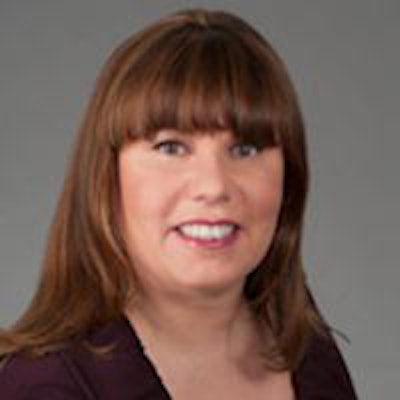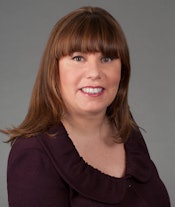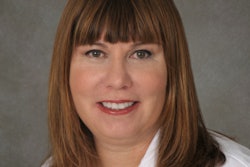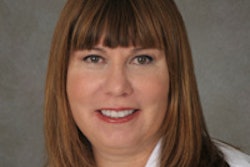
It was cold as I walked along Albany Street, on call and nervous. The first time a patient went to the OR because I said so, I was a wreck. It was a long time ago, before PACS, when radiologists could not hide from interpersonal interactions in the name of efficiency.
 Dr. Mary Morrison Saltz.
Dr. Mary Morrison Saltz.
That day, on a Sunday in Boston City Hospital, I sat nervous to hear the news from the OR. I knew the patient and his family, and had spent time back and forth with the team on how to best evaluate and treat our mutual patient.
I had long face-to-face interactions with the surgeons, discussions of what to do next, and the opportunity to do a hands-on evaluation of the patient during a contrast enema. By the time our patient went to the operating suite, I knew him, had met his family, and had really become a hands-on integral part of his care team.
When they found a life-threatening colonic obstruction, I was relieved to know I had not led the team astray, and was glad he was in good hands. That day the delivery of patient care promoted a true closeness to the team and the center of care, our patient. That was teamwork -- and it happened without effort, part of the natural workflow.
How far we've come
Today, we have become more efficient, and certainly can provide a wealth of information unimaginable in the era of diagnostic enemas. Intestinal obstruction is no longer so primitively diagnosed -- and imagine how much more valuable information is available on a pre-op CT.
Imaging is invaluable in patient care, and advanced imaging is a pillar upon which much care delivery is based. Yet, we have perhaps forgotten the importance of partnering closely with our referring clinicians to create a seamless care team.
Many radiologists say that their report is their "product," and it must be perfect. Refining and redefining the nature of our reports is a key area of ongoing interest.1 Invaluable, but not in isolation -- a report alone is not enough. Without being seamlessly integrated into the team looking after the patients, we may lose our role as a physician and become just that -- a report generator. Efficiency and relative value units (RVUs) determine our revenues, but we must be careful to protect our place in the medical team.
A furor was created when Massachusetts General Hospital and Yale University sent imaging overseas a decade ago.2 Today, many hospitals outsource their nighttime reads. Hospitals may choose to outsource all image interpretation.
If imaging moves outside the hospital, how can we move with it and not lose our role? While we remain hospital-based, how can we increase our worth? Partnering with our colleagues as part of the care team is integral to cementing our role as invaluable resource.
Our future as a profession will be determined by our perceived value -- and this is important to protect and nurture. The information explosion of imaging creates so much data that supercomputers are being used to analyze it!3
On a daily basis, thousands of images are routinely generated per case. The ability to reliably and competently analyze this information is incredible, a task for giants in our field and a central metric of our worth.
Comprehensive, comprehendible, and accurate radiology reports are the sine qua non of our specialty. Reports that impart relevant information to the care team in a meaningful way. Our reports alert our colleagues to critical findings, notify them when follow-up is needed, and transmit information in a way that is understood by those who need to care for the patient.
Going forward, our reports will also find their way directly to our patients via patient portals.4 Perfecting our reports is an ongoing work-in-progress, but our worth as doctors is more than this, and we must be aware that in order to care for the patient it takes a team, and we need to be part of that team. A report does not suffice.
As RSNA 2013 promotes the power of partnership, perhaps we should listen. Technology has served to isolate us from our team, but perhaps it can be used to bring back a personal touch? Check in when we are in the hospital, to signal our availability to our colleagues? Sort of a Foursquare5 meets telemedicine?
Develop interactive platforms to discuss cases, with integration of voice, video, and images for the times we are not there in person? Exploit the power of the iPad6 but not just for image transmission?
Proper exposure is not just for x-rays! Imagers need exposure too. We must not hide at our workstations or we risk losing our place on the team. Good medicine means teamwork, and we need to be there, in the game!
References
- Hall FM. The radiology report of the future. Radiology. 2009;251(2):313-316.
- Pollack A. Who's reading your x-ray? New York Times. November 16, 2003. http://www.nytimes.com/2003/11/16/business/who-s-reading-your-x-ray.html?.
- Saltz JH, Teodoro G, Pan T, et al. Feature-based analysis of large-scale spatio-temporal sensor data on hybrid architectures. Int J High Perform Comput Appl. June 9, 2013.
- Howell WLJ. Personalized radiology improves patient and provider experiences. Diagnostic Imaging website. Published September 17, 2013. http://www.diagnosticimaging.com/practice-management/personalized-radiology-improves-patient-and-provider-experiences.
- Foursquare website. https://foursquare.com.
- Saltz MM. The iPad, teleradiology and your practice-is the time right? Radiology Issues in a Changing World blog. Published August 1, 2012. http://imagineimageinnovation.com/2013/03/09/the-ipad-teleradiology-and-your-practice-is-the-time-right/.
Dr. Mary Morrison Saltz is a board-certified diagnostic radiologist. She is currently chief clinical integration officer for community practice initiatives at Stony Brook Medicine and a member of their department of radiology. She is also CEO of Imagine Image Innovation, a company that uses big data to improve delivery of radiology services.
She has also served as chief medical officer for Hospital Radiology Partners and as radiology chair and service chief at hospitals in Florida, Ohio, and Georgia. Dr. Saltz is a member of the American College of Physician Executives, the American College of Radiology, and RSNA, and she sits on the Citizens Advisory Council of the Duke Cancer Institute.
A hands-on leader, Dr. Saltz's expertise is working hand-in-hand with hospital administration to guide radiology teams to success. Dr. Saltz has led quality assurance programs in Florida and Ohio and she served as chief quality officer for community practice initiatives at Emory Healthcare. She also has more than 20 years of private-practice experience.
She is a graduate of McGill University, with a Bachelor of Science in Human Genetics, and Duke University, where she obtained her Doctor of Medicine. Her postgraduate education included a residency at Boston University, where she served as chief resident, and a fellowship in interventional abdominal radiology at Massachusetts General Hospital.
The comments and observations expressed herein do not necessarily reflect the opinions of AuntMinnie.com.



















